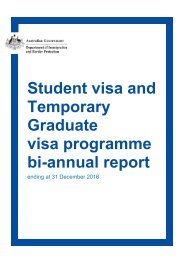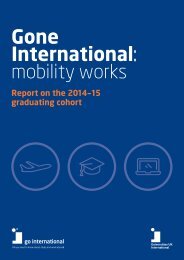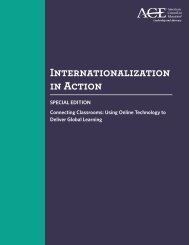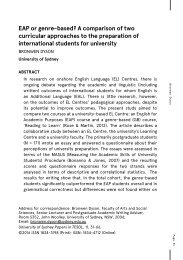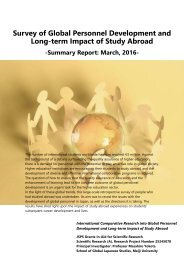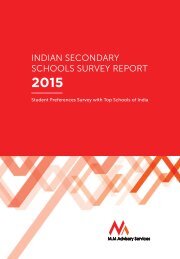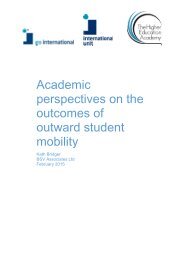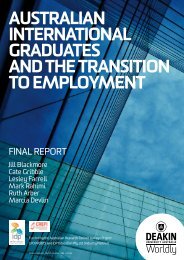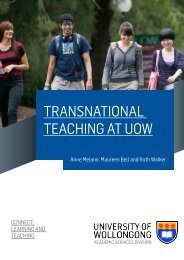internships-and-work-placement-opportunities-for-international-students-in-victoria-ieaa-report-october-2012
internships-and-work-placement-opportunities-for-international-students-in-victoria-ieaa-report-october-2012
internships-and-work-placement-opportunities-for-international-students-in-victoria-ieaa-report-october-2012
You also want an ePaper? Increase the reach of your titles
YUMPU automatically turns print PDFs into web optimized ePapers that Google loves.
There is no s<strong>in</strong>gle model extant <strong>for</strong> manag<strong>in</strong>g <strong>and</strong> support<strong>in</strong>g WIL. Some <strong>in</strong>stitutions manage WIL at a<br />
central level, others at the faculty/school discipl<strong>in</strong>e level. Some <strong>in</strong>stitutions employ Industry Placement<br />
Officers, WIL coord<strong>in</strong>ators, Industry Based Learn<strong>in</strong>g consultants <strong>and</strong> Careers officers to support their<br />
programs. Academic champions <strong>and</strong> adm<strong>in</strong>istrative leaders are seen unanimously as critical to<br />
successfully resourc<strong>in</strong>g <strong>and</strong> deliver<strong>in</strong>g WIL.<br />
A noticeable recent trend among <strong>in</strong>stitutions, universities particularly, is consideration of WIL as a part<br />
of their strategic review <strong>and</strong> vision<strong>in</strong>g processes, with the <strong>in</strong>tention if possible of differentiat<strong>in</strong>g the<br />
<strong>in</strong>stitution from competitors. This aligns well with the focus of the Victorian Government through the<br />
current research project.<br />
Industry snapshots – Approaches to WIL <strong>for</strong> <strong><strong>in</strong>ternational</strong> <strong>students</strong> <strong>in</strong><br />
Victorian tertiary <strong>in</strong>stitutions<br />
Sw<strong>in</strong>burne University of Technology has just completed a full audit of all <strong>work</strong>-<strong>in</strong>tegrated learn<strong>in</strong>g<br />
<strong>and</strong> <strong>in</strong>dustry based learn<strong>in</strong>g (IBL) <strong>in</strong> the university, identify<strong>in</strong>g barriers to <strong><strong>in</strong>ternational</strong> student<br />
participation. The detailed f<strong>in</strong>d<strong>in</strong>gs are <strong>for</strong> <strong>in</strong>ternal use only but <strong>in</strong>dicate that while overall the<br />
university has a good approach to IBL, more could be done <strong>in</strong> relation to <strong><strong>in</strong>ternational</strong> <strong>students</strong>. The<br />
audit <strong>in</strong>vestigated the reasons <strong><strong>in</strong>ternational</strong> <strong>students</strong> might be excluded from IBL <strong>and</strong> exam<strong>in</strong>ed<br />
how the university might <strong>in</strong>crease access. Faculties are hesitant to make WIL or <strong>work</strong> <strong>placement</strong>s<br />
m<strong>and</strong>atory <strong>for</strong> <strong><strong>in</strong>ternational</strong> <strong>students</strong> because of the shortage of <strong>placement</strong>s with<strong>in</strong> the local<br />
employer community <strong>and</strong> the resources required to place <strong><strong>in</strong>ternational</strong> <strong>students</strong>.<br />
Australian Collaborative Education Net<strong>work</strong> (ACEN) is currently <strong>work</strong><strong>in</strong>g on a project focused<br />
on WIL leadership, consider<strong>in</strong>g the structures <strong>and</strong> leadership competencies required to operate<br />
WIL. Early <strong>work</strong> draw<strong>in</strong>g on a case study of structural approaches to WIL <strong>in</strong> universities shows that<br />
a distributed leadership model is required <strong>and</strong> that this needs to be tailored depend<strong>in</strong>g on the<br />
<strong>in</strong>dustry needs.<br />
VET approach to WIL leadership Work <strong>and</strong> <strong>in</strong>dustry <strong>placement</strong>s are commonplace <strong>in</strong> many<br />
vocational education courses <strong>and</strong> <strong>in</strong> some cases tra<strong>in</strong><strong>in</strong>g packages m<strong>and</strong>ate a <strong>work</strong> <strong>placement</strong>.<br />
However, the majority of <strong>placement</strong>s are determ<strong>in</strong>ed through the <strong>in</strong>stitution’s delivery strategy.<br />
Industry engagement is also m<strong>and</strong>ated as part of the Australian Quality Tra<strong>in</strong><strong>in</strong>g Frame<strong>work</strong> where<br />
VET <strong>in</strong>stitutions must evidence their engagement with <strong>in</strong>dustry. This has placed the broad theme of<br />
<strong>in</strong>dustry engagement at the <strong>for</strong>efront of th<strong>in</strong>k<strong>in</strong>g of CEOs <strong>and</strong> managers <strong>in</strong> VET <strong>in</strong>stitutions.<br />
Approaches to <strong>in</strong>ternship <strong>and</strong> <strong>work</strong> experience <strong>in</strong> tertiary <strong>in</strong>stitutions<br />
A variety of approaches operate to deliver <strong><strong>in</strong>ternships</strong> <strong>and</strong> <strong>work</strong> experience. Table 2 (p.19) describes<br />
the three ma<strong>in</strong> approaches – optional <strong>placement</strong>, elective <strong>placement</strong> <strong>and</strong> m<strong>and</strong>atory <strong>placement</strong> –<br />
together with the resource/risk levels <strong>in</strong>volved.<br />
18





